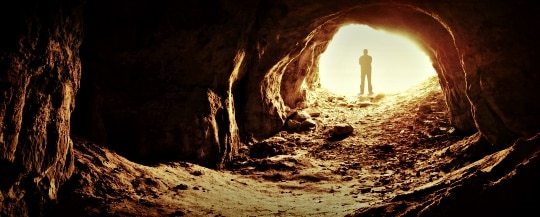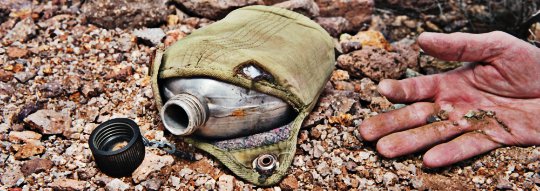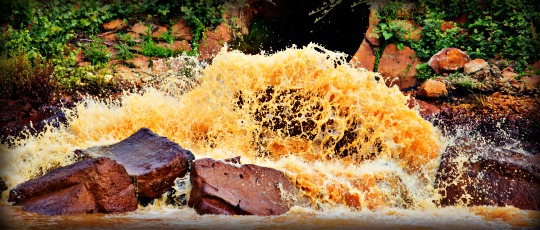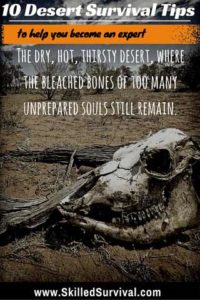
Because deserts present a unique survival challenge. They are unlike other survival environments… From the blistering heat to the venomous critters and the lack of water. It may be the MOST terrifying place to get stranded.
That’s why I’ve compiled this list of 10 Desert Survival Tips.
Desert Survival Introduction
The danger of deserts never crosses one’s mind from the safety of our air-conditioned vehicles. Because we’re safely isolated from its unbearable heat.
WE absentmindedly swallow chilled water to quench our thirst. But don’t be a fool.
Just one mishap, and you’ll get your chance to experience this unforgiving place. Are you prepared for it? I sure hope so. And not only does the desert inflict its pain with heat and dry alone.But it has more hidden survival traps to offer.
Dangerous ones, such as venomous snakes, scorpions, dust storms, and flash floods.
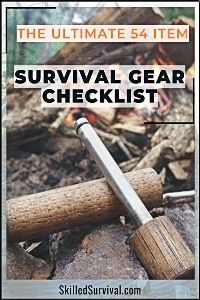
Want a free 54 item survival gear checklist?
Enter your email below to instantly download this Complete Checklist PDF. No purchase necessary. 👇 👇1. Tell Someone You Trust Where You’re Going
Anytime you travel into or through a desert, tell someone. This is a wise survival tip for any outdoor adventure, not just the desert. Have you ever heard the name Aron Ralston?
His story is a famous one in the survival realm. His “adventure” was captured in the movie in 127 hours.
↓ 127 Hours – Full Length Offical Trailer HD
Aron took a solo trip into the desert for some canyoneering. But accidents happen, and his hand is crushed and trapped by a shifting boulder.
I won’t ruin the movie for those who haven’t seen it yet. But believe me, he severely regrets not telling anyone where he was going. Don’t make the same mistake.
Tell someone you trust. Someone who will notice if you go missing. Telling a gas station attendant on the edge of a small-town U.S.A. doesn’t count. They won’t notice should you go missing. And if by some miracle they do, they probably won’t care enough to contact the authorities.
Instead, tell a family member or a close friend. Tell them when you’re leaving, where you’re going, and when you expect to return. And resist the urge to deviate from your plan once shared. Because if something horrible does happen, that person will alert rescuers in a timely manner.
And they’ll have a very specific area to focus their search efforts.
2. Keeping Cool
This desert survival tip might seem a bit counterintuitive at first. Because if you get stranded in a desert with no water, shouldn’t seeking water be a higher priority?
Deserts are hot, and water is hard to find, right? Yes, that’s true. However, wandering in the brutal heat and searching for water will increase your dehydration rate. Another way to think about hydration is by using a very simple math equation.
[Water In (-) Water Out].
Where [Water In] equals Water Consumed and [Water Out] equals Water Eliminated through Waste and Sweat.
So dehydration begins when this equation gets out of balance.
When [Water In] is less than [Water Out] for a significant period of time. And if this balance is not eventually corrected it leads to death.
Now, using this basic hydration equation, there are two ways to reduce the speed of death by dehydration.
- You can either find and consume water (i.e., increase [Water In])
- Or mitigate water losses (i.e., decrease [Water Out])
And in a brutally hot North American desert, in the middle of the day, mitigating water loss is a wise choice. Better than stumbling around searching for an oasis that probably doesn’t exist…
The risk/reward of searching for a rare water source with the sun beating down sucks. You’re guaranteed to lose lots of water through sweat. While there’s only a slim chance of finding enough water to replenish your lost amount. That’s what I call a sucker’s bet.
Instead, seek shade and get some rest during the hottest part of the day. You’ll need it since you’ll be strategically active in the evenings when the temperatures drop.
↓ No Food & Primitive Shelter in the Desert
That’s when it’s time to travel, search for water and food, and build a solar still. Also, avoid sitting directly on the hot ground.
Any desert ground that bakes in the sun for hours will retain that heat. Instead, seek ground that’s been in the shade for a while.

Want a free 54 item survival gear checklist?
Enter your email below to instantly download this Complete Checklist PDF. No purchase necessary. 👇 👇3. Learn How To Make A Solar Still
If you often travel in or near a desert, do yourself a favor and stash some thin plastic in your survival pack or vehicle. Why? Because this gives you the ability to make a solar still. And if you can craft a solar still, you can collect some much-needed water.
Solar stills are ingenious yet simple survival contraptions. They’re designed to create a miniature “greenhouse”. Heat enters through the plastic vapor barrier but gets trapped and cannot escape. This increasing heat forces the moisture in the soil to vaporize. Creating a trapped humid atmosphere under the vapor barrier.
Then, once night comes, the temperatures will drop, and the moisture in the air will condense on the plastic. You can collect this condensed water in a small container when set up properly.
Here are the basic steps to create a desert solar still:
- Dig a round hole a few feet wide and a few feet deep
- Setup a small collection pit at the center of the hole using a plastic sheet
- Stretch your thin sheet of plastic across the hole
- Find some moderately heavy rocks to hold the plastic sheet in place around the hole
- You want the plastic sheet to be high off the ground but with a slight drop to the middle of the hole. To this end, add a medium-sized rock to the center of the sheet.
Now, the plastic sheet will help collect the moisture.
Water will slowly build up on the plastic sheet, and as it builds, it will run toward the center of the plastic. Then, once the water collecting in the center of the plastic sheet gets heavy enough, it will drop into your small collection pit. This process won’t fill an entire water bottle in a desert, but it may be enough to slow your dehydration rate.
Here’s a video showing you step-by-step how to build this desert survival tip.
↓ Emergency Water Source – Evaporating with a Solar Still
4. Don’t Worry About Food
This desert survival tip boils down to statistics and probabilities. The good news is your odds of dying of starvation in a desert survival situation are very low. Why? Because you’ll likely be long dead from dehydration, injury, or rescued before starvation sets in.
A relatively healthy person can survive at least three weeks without food. Your body will begin by using your fat reserves and then stealing your muscle fibers to keep you going. Since death by starvation is a slow process, save your energy for other survival priorities.
That said, don’t be an idiot and pass up a free lunch if one happens to present itself. If you stumble on some bird eggs, snatch a rodent passing by, or can quickly kill a snake, then, by all means, eat up. But if a food source doesn’t readily present itself, try to ignore the rumbling noises coming from your stomach.
You have more critical survival issues to worry about right now.
↓ Cactus Eating – Desert Survival – Food & Water

Want a free 54 item survival gear checklist?
Enter your email below to instantly download this Complete Checklist PDF. No purchase necessary. 👇 👇5. Don’t Build Fires During The Day
You should build fires, just not during the heat of the day. For one, building a fire takes energy. And remember, we need to save our energy and mitigate water loss by avoiding sweating.
Plus, fires are hot, duh! So the last thing you need in the middle of a brutally hot desert day is more heat.
But what about using fire for signaling? During the day, it’s better to use a signaling mirror (if you have one) or a shiny knife blade. These tools work great to flash bright sunlight at a passing helicopter or airplane.
The exception to this rule is if you can create thick black smoke. If you’re stranded with your vehicle, drain and burn its oil. Burning oil creates thick black smoke that rescuers will spot from many miles away.
So the best time to build a fire in a desert is at night, for three reasons:
- A rescue team will spot even a small fire at long distances in a desert environment.
- Deserts can get bitterly cold at night, sometimes cold enough to make hypothermia a concern, especially if the only thing you’re wearing is shorts and a tank top. So you’ll need the warmth of a fire to keep you alive.
- Fires also help keep desert predators at bay such as coyotes, bobcats, or mountain lions.
So, another good desert survival tip is to pack multiple ways to spark a fire in your survival bag and vehicles. I recommend you stash fire strikers, waterproof matches, and a quality survival lighter.

Want a free 54 item survival gear checklist?
Enter your email below to instantly download this Complete Checklist PDF. No purchase necessary. 👇 👇6. Keep An Eye Out For Rattlesnakes
Speaking of dangerous animals, in a desert, you’re more likely to die from a rattlesnake bite than getting mauled by a bobcat. So, you’ll need to be diligent about where you rest.
Carefully scope out the perimeter of any area you plan to sit or sleep in. The last thing you can afford is to end up with a poisonous snake bite. Those are what I like to call “survival game enders.”
You’ll also want to watch out for sidewinders.
↓ The Rattlesnake Cave – Desert Survival – Catch and Cook
Many people fear scorpions in the desert, but scorpion stings are rare.
Pay attention to where you’re sitting down, and you should be safe from scorpions.
7. Flash Floods Are Rare But Deadly
You read that correctly; you need to think about floods in a desert. Why? Because the desert ground is dry and hard from lack of regular rain. So when a rare deluge does occur, it won’t soak in. It will run and collect, turning quickly into a dangerous flash flood.
Plus flash floods are a leading cause of death in the desert.
As recently as September 2015, 18 people died in desert flash floods near the Utah-Arizona border in the United States. So, while the downpour may seem an answer to your survival prayers, it may end up being your ultimate demise. Especially if you’re swept away by the powerful floodwaters.
Being carried away by a mass of rushing water is a helpless situation. The initial wall of water will knock you off your feet, sweep you away, and drown you in seconds. Or it may just bash you against a nearby rock cliff.
So flash floods should be a matter of concern when choosing a resting location.
The bottom line is: Dry channels, ditches, and lake beds are poor choices for napping. These low-lying sites can fill up quickly during torrential downpours.
Flash floods are also deadly in slot canyons, so be extra cautious if traveling through them. Here’s some great video footage showing these desert flash floods’ power.
↓ Amazing Flash Flood / Debris Flow Sothern Utah HD
8. Don’t Leave Your Vehicle
If stranded in a desert with a vehicle, Do. Not. Leave. It. The only exception to this desert survival tip is if you know for a fact civilization is only a few miles away. In that case, abandoning your vehicle and traveling to civilization may make more sense.
But be smart about it, and do so in the morning, evening, or night, not in the day’s heat. Just in case, it’s a longer distance than you anticipated. OK, so why should you stay with your vehicle? Because it’s an object that will stick out to rescuers from the air and it’s full of useful survival items.
Here are a few of the best ones:
- Mirrors – Vehicle mirrors work great for shining bright sunlight at passing rescuers.
- Fuel—Gas or diesel are both flammable and can be used to make fires. However, gas is also very explosive, so take extreme care if you decide to use it.
- Oil—If you can collect and burn the engine oil during daylight hours, it will spew out thick black smoke, which will draw the attention of rescuers from miles around.
- Battery – You can use a battery to make sparks. Sparks can be used to create fire.
- Horn – Loud noises may get the attention of others who are in the area.
- Hood – A raised hood is a universal signal for a broken-down vehicle and someone who needs help.
- Roof—Stay under your vehicle’s roof to avoid the sun. Just make sure you keep the doors and windows open to avoid sitting in an oven.
So as you can see, there are many solid survival reasons to stay with your vehicle. Unfortunately, the unprepared masses let fear take over.
They will get scared at the first signs of trouble. Panic causes them to ditch their vehicles right away, which often turns out to be a poor choice. And if you’re forced to ditch your vehicle, be smart and leave a note behind.
A couple of scribbled-out sentences will tell rescuers where you are headed and when you left. Both are vital bits of information to help rescuers find you faster.
9. Surviving Dust Storms
Dust storms suck. They suck even worse if you’re forced to endure them out in the elements. If you have a vehicle, ride out the storm in it.
You may want to shut the doors and roll up the windows too, but be mindful of overheating. You may need to crack the windows to avoid sitting in an oven. If no vehicle is available, then look for large boulders or low-lying outcrops for shelter.
You can use these natural features to create a shield to block the worst of it. You should also create a makeshift survival bandana to cover your nose and mouth.
The last thing you need when you’re suffering from severe thirst is to add a bunch of sand and dust to your lungs. Hopefully, the dust storm passes quickly and clears out after a few minutes. Because it won’t be much fun riding out one that lasts hours.
Honestly, the only thing you can do about dust storms is to hunker down and wait them out. Here’s some dust storm footage to give you a sense of what it’s like to experience one.
↓ Top 5 Sandstorms Caught on Video

Want a free 54 item survival gear checklist?
Enter your email below to instantly download this Complete Checklist PDF. No purchase necessary. 👇 👇10. Cactus Water Is The Last Resort
Drinking more than a few sips of cactus water can make you severely sick. We’re talking diarrhea sick. Diarrhea accelerates the dehydration process. So, if you’re truly in the final stages of death via dehydration, then try sipping a little bit of cactus water.
You’ve got nothing to lose at that point. But generally, avoid drinking cactus water; Desert Survival isn’t a Hollywood movie. However, you should take the time to learn about a few edible and useful plants in the desert.
Desert Survival Tips Action Plan
So those are my 10 best desert survival tips. But before you go, I have a question for you, “what will you do with this information?”
If the answer is nothing, then you’re no better off than before you read this article.
Instead, do yourself a favor and follow my advice to help: Always have your essential everyday survival gear with you. No exceptions. It’s a fundamental rule of survival and preparedness.
If you’re on foot, pack your everyday survival gear. Toss your survival pack in the back if you’re in a vehicle. That way, if life throws you into the hot, dry desert, you’ll have your essential gear to help you survive.

Prepare, Adapt & Overcome,
P.s. - I just found out 2 out of 3 Americans don’t feel prepared for a 3 day disaster!!!
I guess this goes to show how modern society continues to embrace ‘living a fragile life.’ What’s crazy is… it’s so easy to fix.
To make sure YOU have the basics, watch our FREE training on “10 Simple Steps To Basic Preparedness” that shows you HOW.
Nothing crazy here… this isn’t doomsday prepping... just the basics every responsible adult should have before a disaster strikes.Why You Can Trust Skilled Survival...
Go here now to review a full breakdown of:
- Who We Are
- Our Credentials
- Our Mission
- & Product Recommendations...
Here are a few highlights of our teams credentials & certifications:
- Certified Member of a Mountain Search & Rescue Organization
- Plant Emergency & Safety Leader for a Major Food Manufacturer
- Member of the 10TH Mountain Division Hut Association
- Certifications: Avalanche 1, WFR, CPR
- Official Gear Tester for Numerous Outdoor Gear Companies
- Countless Multiday Backpacking trips into Remote Wilderness
- Bachelor's Degree In Mechanical Engineering
- Bachelor's Degree In Civil Engineering
- Bachelor's Degree In Biomedical Engineering
"It takes 20 years to build a reputation and five minutes to ruin it." - Warren Buffett
We're fully aware that trust is NOT something you GET but is EARNED.
And we'll continue to earn YOUR trust through our forthright and honest approach with each new Blog Post, Guide & Product we create...
P.s - I just took this FREE 60-second 'Readiness Score Quiz'👇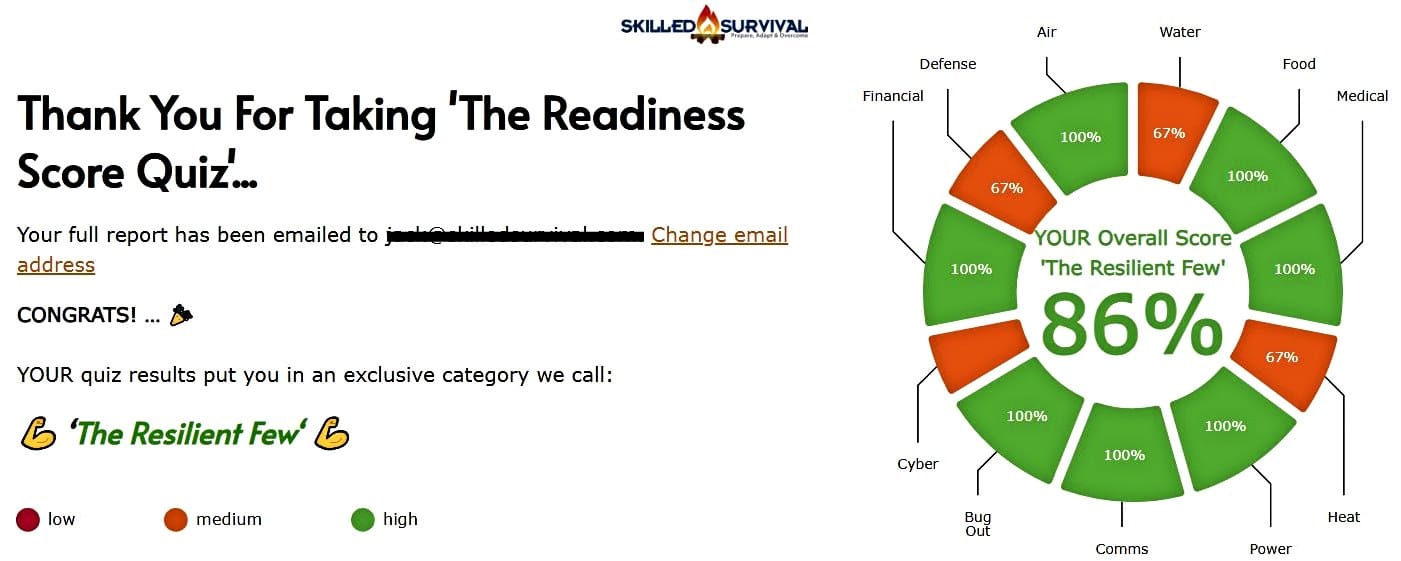
AND... I've still got a few gaps in my preps...🤔 But at least, I'm not part of 'The Fragile Masses'. 👍 Find out where YOU stand by answering a few questions...

Recommended Reading
Survival Pack: How To Build One NOW (before SHTF)
A complete list of critical items that need to be in your survival pack before heading out into the wilderness.
Survival Packing List: Best For An Evacuation
Everyone needs a survival packing list to organize their escape. That way you won't regret leaving something critical behind.
Wild Edible Plants: The 13 Best Ones ANYONE Can Find
Discover the best wild edible plants you can find and eat nearly anywere. Knowing and identifying these wild edibles could save your life.
How To Make Catfish Bait: My Grandpa’s Ultimate Recipe
I want to share with you what I consider the best catfish bait recipe. Here's how to make stink bait that will get the catfish to bite.
Paracord Projects: 17 Useful Survival Tools You Can Make Today
I share the best paracord projects that are both fun and useful. By doing these crafts you'll always have lifesaving cordage on hand.
Survival Skills: The Ones Everyone Should Master
The best survival skills will keep you alive even in extreme conditions. 1. Water 2. Shelters 3. Fire 4. Navigation 5. Signaling 6. Medical


